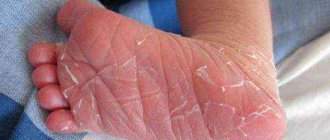What is cyanosis
Cyanosis is the blueness of the lips, mucous membranes or other parts of the body. Skin color can range from grayish to almost black. This condition means that the concentration of hemoglobin in the blood is increased or most of it is saturated with carbon dioxide. When blood circulation is impaired, areas distant from the heart turn blue - fingers, lips, ears and nose.
True cyanosis is of two types:
- Central, which develops as a result of oxygen starvation caused by several reasons.
- Peripheral cyanosis occurs when blood stagnates in the tissues.
A change in skin color that is not related to the amount of oxygen is called false cyanosis.
Its appearance is often provoked by external factors. This could be cold or eating certain foods.
What it is
Cyanosis is a symptom of oxygen deficiency in the body, which increases the formation of methemoglobin. It is this reduced type of hemoglobin that makes the skin and mucous membranes darker.
Blue discoloration of the epidermis in the area of the nasolabial triangle in infants can be of a pathological and physiological type.
What can blue lips say?
Sometimes skin discoloration is harmless and does not require seeing a doctor, but it occurs very rarely for no reason. Children more often develop peripheral or adolescent cyanosis. For babies under one year old, blueness of the nasolabial triangle may mean slow blood circulation or congenital heart problems.
Timely oxygen therapy helps to avoid the transition to the stage of a full-fledged disease.
If the first signs of the condition are not paid attention to, severe pathologies of the heart, blood vessels or lungs develop. They cause a slowdown in blood flow to the brain and a change in its structure. The level of hemoglobin and red blood cells increases, the plasma becomes viscous, and the risk of blood clots increases.
Causes
Cyanosis is a serious condition, the causes of which must be clarified and promptly eliminated. Not in all cases of blue lips you need to immediately go to the doctor. The appearance of such a condition is considered normal if the child has been exposed to cold for a long time, for example, swam in the pool, walked outside in winter.
Medical help is needed when the blueness of the lips is not due to the fact that the baby is cold or has eaten blue-colored foods, such as blueberries.
Common causes of cyanosis in children:
- Congenital and chronic diseases - pneumonia, asthma attack, heart disease and some others. They are accompanied by additional symptoms.
- Lack of air , which can occur in a stuffy, unventilated room.
- Physical exhaustion. Lips turn blue with extreme fatigue and overexertion.
- Drug overdose. A common cause of blue lips due to medications is taking antibiotics.
Associated symptoms
To determine the degree of danger of a situation, the presence or absence of other signs should be identified. A child's blue lips and cold hands often indicate that he is simply cold, even if he does not admit it. In the absence of other symptoms, the condition is not dangerous. When cyanosis is accompanied by suspicious signs or the baby’s behavior changes, you should carefully evaluate his well-being.
Associated symptoms:
- A cough - dry, wet, with phlegm, pus or blood - indicates the presence of pulmonary diseases. Some of them can cause suffocation in a few minutes, so if you have cyanosis along with a cough, call a doctor immediately.
- Impaired breathing. Difficulty inhaling and exhaling, wheezing, shortness of breath are symptoms of air entering the pleural cavity. Bubbling breathing occurs with pulmonary edema. Whistling and mucus production during exhalation are signs of asthma.
- Cyanosis during meals. The condition may indicate malformations of the esophagus or heart.
- Cramps. If they are observed against the background of blue lips in a child, this indicates the presence of heart defects.
- Temperature. Indicators increase with the development of pneumonia, fever is accompanied by chest pain, chills and cough.
What do we have to do
If your baby's area above his upper lip turns blue, you need to look at why it appears. If a symptom occurs during bathing and quickly disappears, it does not pose any danger to the baby’s health. If this skin condition persists, you should:
- Contact your pediatrician as soon as possible. At your appointment, the doctor may prescribe additional tests to make the correct diagnosis and tell you why the upper lip area turns blue. Among the procedures, the doctor may prescribe: an electrocardiogram, an ultrasound examination of the heart muscle, and an x-ray of the chest area. Also, in some cases, it is necessary to visit a neurologist to conduct a complete examination of the child.
- change your lifestyle. It is necessary to maintain optimal temperature and air humidity in the room where the child is. You should go for walks more often, and also soothe the baby when crying. This advice also applies to healthy children, since correct and timely development occurs only in a comfortable environment.
- Do massage. Carrying out a daily massage will stimulate the activity of the nervous system, as well as normalize the functioning of the respiratory system. If a foreign body enters the child's respiratory tract, you should carefully and quickly place the baby stomach down on your lap and lightly hit him on the back. If this method does not work, you should urgently call a doctor to prevent the appearance of blue skin in the area of the nasolabial triangle, as well as suffocation.
Post published by Kitty390 April 21, 2011
2
I’ve been wanting to ask for a long time: the child has pale skin and sometimes blue around the mouth. Is there any reason to worry or is this a feature of it?
Conditions of the body that provoke blue discoloration
- Loss of consciousness. Some young children have increased excitability of the nervous system. They scream so loudly that when they inhale, breathing stops and hypoxia develops, which leads to convulsive fainting.
- Anemia. Lack of iron causes malfunctions of the cardiovascular system, cyanosis is one of the signs of acute vitamin deficiency.
- Suffocation. The reason is often the blockage of the respiratory tract by a swallowed toy or other object.
- Shock. The condition develops as a result of extreme situations (trauma, burns, blood loss, allergies). It is accompanied by shortness of breath, confusion, and rapid pulse.
- Gas poisoning. The child has a very sensitive respiratory system. Even a small amount of toxic substances in the air (carbon monoxide, cigarette smoke) can cause intoxication.
- Frostbite. Prolonged stay outside in cold weather can lead to blue lips. If they lose sensitivity, it is frostbite. Consult a doctor; do not try to warm your lips with hot objects.
Treatment
Therapeutic measures directly depend on what exactly is the cause of the cyanosis of the nasolabial triangle:
- if a heart defect is diagnosed, you need to consult a pediatric cardiologist, perhaps we will talk about the need for surgery;
- in case of pathology of the nervous system, an in-person examination by a neurologist is necessary; he will tell you how to proceed;
- Pneumonia in children is treated in a hospital setting, using antimicrobial and anti-inflammatory drugs.
Regular walks in the fresh air and daily ventilation of the children's room are recommended as preventive measures. Care must be taken to ensure that the child breathes comfortably. If the air in the house is too dry, it is worth purchasing a humidifier; at the same time, this will serve as a good prevention of acute respiratory infections and acute respiratory viral infections. Smoking should also not be allowed in the house where the child is.
We also recommend reading: alopecia in children
Such a phenomenon as a blue nasolabial triangle in a baby occurs quite often, and in many cases does not pose a danger to the child’s health. However, there are situations when such a symptom manifests itself as a dysfunction of the cardiovascular system, as well as the respiratory system. What is cyanosis and why does it appear?
When to sound the alarm
There are a lot of conditions under which cyanosis develops in children, and it is difficult for parents to immediately understand the cause. Pediatricians believe that all cases that are not related to the fact that the baby is cold require medical attention.
If a child’s lips are blue, he is breathing heavily, this accompanies inappropriate behavior, call emergency help without unnecessary proceedings.
Dangerous signs of cyanosis:
- no reaction to external stimuli;
- dyspnea;
- high fever;
- rapid pulse;
- excessive vomiting or diarrhea;
- chest pain.
Pathological causes of blue skin around the mouth in an infant
Before you panic, pay attention to a few factors:
- Does the cyanosis quickly disappear after warming/calming;
- whether any disruptions in the functioning of the heart were discovered shortly after birth;
- Are other parts of the baby’s body turning blue (fingertips, tongue, entire upper body);
- Does your child seem sleepy and lethargic?
The list of diseases that can cause blueness around a baby’s mouth is quite long, but we will name the main ones.
- Heart pathologies.
An open foramen ovale, insufficiency of one of the heart valves, or a combination of several defects. Heart disease is the most common cause of blue discoloration around the mouth. - Problems with the respiratory system.
inflammation of the bronchi, bronchial asthma, pneumonia and even a common runny nose. - Neurological diseases.
For example, the immaturity of certain areas of the brain. A child may also turn blue around the mouth after a birth injury. Typically, cyanosis of the perioral area in such cases is combined with other neurological symptoms.
Emergency situation
So, we have already figured out why an infant may turn blue around the mouth and realized that in most cases this is the absolute norm. But there are situations when the child’s skin around his mouth suddenly turns blue, and he himself looks pale. This happens if a child chokes on a foreign body. Call an ambulance and start rescuing immediately!
- Place your baby's stomach on your forearm or knee and, keeping your chin firmly in place, hit the back with the heel of your hand five times, moving at a 45-degree angle and from front to back;
- If this does not help, turn the child over and hit the lower chest with two fingers five more times;
- Repeat the techniques until the stuck object falls out or a medical team arrives.
If your child's skin around his mouth turns blue, it is most likely not dangerous and will go away on its own. But, if you think that something is wrong, do not hesitate to ask questions and tell your doctor about your suspicions. And, of course, do not neglect routine inspections.










